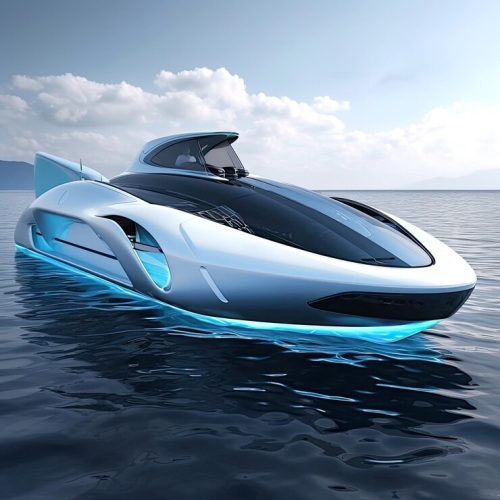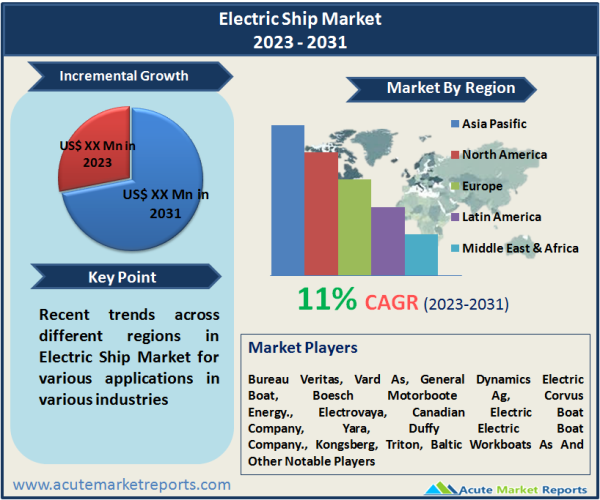
The electric ship market is undergoing a transformative phase driven by technological advancements, environmental considerations, and geopolitical shifts. The electric ship market is expected to grow at a CAGR of 11% during the forecast period of 2025 to 2033. As we transition from 2025, marked by substantial revenues, to the forecast period of 2025 to 2033, the Electric ship market is poised for continued expansion. The ongoing drivers and innovative strategies employed by key players are expected to shape the landscape of Electric ships, contributing to the development of maritime transportation that not only meets the evolving needs of the industry but also aligns with sustainability goals and the broader objectives of a cleaner and more efficient maritime future.

Advancements in Electric Propulsion Systems: Catalyzing Technological Innovation
Advancements in electric propulsion systems stand out as a primary driver in the Electric ship market. Evidence includes the rapid evolution of electric propulsion technologies, such as advanced electric motors, power distribution systems, and energy storage solutions. These innovations have been instrumental in enhancing the efficiency, reliability, and overall performance of electric ships. The evidence further showcases successful deployments of electric propulsion systems in various naval vessels and commercial ships, emphasizing the transformative impact on maritime transportation. As the industry continues to invest in research and development, the evolution of electric propulsion is expected to be a key driver shaping the future of Electric ships.
Environmental Sustainability and Regulatory Pressures: Driving Adoption of Electric Propulsion
Environmental sustainability and regulatory pressures emerge as influential drivers propelling the adoption of electric propulsion in the maritime industry. Evidence includes stringent emission regulations and a growing awareness of the environmental impact of traditional propulsion systems. This driver is underscored by the global maritime community's commitment to reducing greenhouse gas emissions and transitioning towards cleaner, more sustainable transportation solutions. The evidence further highlights the role of electric ships in mitigating environmental risks, with fully electric and hybrid power sources gaining prominence. As international regulations continue to evolve, Electric ships are poised to play a pivotal role in achieving the industry's sustainability goals.
Geopolitical Considerations and Energy Independence: Shaping National Security Strategies
Geopolitical considerations and the pursuit of energy independence emerge as significant drivers shaping the Electric ship market. Evidence includes nations recognizing the strategic importance of reducing dependence on fossil fuels for naval fleets. This driver is reflected in the increasing investments and initiatives by countries to develop electrically powered naval vessels, reducing vulnerability to fuel supply disruptions. The evidence further underscores the geopolitical shift towards prioritizing energy-efficient and technologically advanced naval capabilities. As nations strive for energy independence and enhanced security, the demand for Electric ships is expected to witness substantial growth.
Infrastructure Challenges for Electric Charging: Addressing Charging Infrastructure Limitations
A significant restraint in the Electric ship market revolves around infrastructure challenges related to electric charging. Evidence includes limitations in the availability of comprehensive electric charging infrastructure for maritime applications. This restraint is further emphasized by the need for standardized charging solutions across ports to support the widespread adoption of Electric ships. The evidence also includes instances where the absence of adequate charging infrastructure has hindered the seamless integration of electric ships into global maritime networks. This infrastructure challenge highlights the importance of collaborative efforts between governments, port authorities, and industry stakeholders to overcome barriers and accelerate the adoption of Electric ships.
By Power Output: Dominates the Market
In 2024, the Electric ship market witnessed substantial revenue from ships with a power output ranging from 746 kW-7,560 kW, demonstrating the highest revenue. Simultaneously, ships with a power output of >7,560 kW showcased the highest CAGR during the forecast period from 2025 to 2033, indicating a notable shift towards higher power capacities. This nuanced segmentation reflects the industry's responsiveness to diverse power requirements and the demand for Electric ships across different segments, from smaller vessels to larger naval platforms.
By Power Source: Hybrid Electric ships to Promise Significant Opportunities during the Forecast Period
Market segmentation by power source in 2024 showcased robust revenue streams from both fully electric and hybrid electric ships. However, fully electric ships dominated, reflecting the industry's inclination towards cleaner and more sustainable propulsion solutions. Looking at the highest CAGR during the forecast period, hybrid electric ships demonstrated the most significant growth potential. This nuanced segmentation underscores the versatility of Electric ships, accommodating various power sources to meet specific operational and environmental requirements.
APAC Remains the Global Leader
Geographically, the Electric ship market displayed diverse trends in 2024, with Asia-Pacific leading in both revenue generation and the highest CAGR. This reflects the region's dominance in shipbuilding and the increasing focus on sustainable maritime solutions. Europe also contributed significantly to revenue, indicating a growing market with a strong emphasis on environmental regulations. North America, while mature, maintained a steady demand for Electric ships, driven by both commercial and naval applications. These geographic trends underscore the global nature of the Electric ship market, with different regions playing key roles in its growth and evolution.
Market Competition to Intensify during the Forecast Period
In the competitive landscape, top players such as Bureau Veritas, Vard As, General Dynamics Electric Boat, Boesch Motorboote Ag, Corvus Energy., Electrovaya, Canadian Electric Boat Company, Yara, Duffy Electric Boat Company., Kongsberg, Triton, Baltic Workboats As And Other Notable Players are driving innovation and shaping the future of Electric ships. These key players reported substantial revenues in 2024, expecting continued growth from 2025 to 2033. Their strategic focus on advancing electric propulsion systems, addressing infrastructure challenges, and adapting to geopolitical shifts positions them as influential entities in the Electric ship landscape. As the market evolves, these players are anticipated to play a pivotal role in advancing technologies and ensuring the continued adoption and integration of Electric ships into global maritime operations.
Historical & Forecast Period
This study report represents analysis of each segment from 2023 to 2033 considering 2024 as the base year. Compounded Annual Growth Rate (CAGR) for each of the respective segments estimated for the forecast period of 2025 to 2033.
The current report comprises of quantitative market estimations for each micro market for every geographical region and qualitative market analysis such as micro and macro environment analysis, market trends, competitive intelligence, segment analysis, porters five force model, top winning strategies, top investment markets, emerging trends and technological analysis, case studies, strategic conclusions and recommendations and other key market insights.
Research Methodology
The complete research study was conducted in three phases, namely: secondary research, primary research, and expert panel review. key data point that enables the estimation of Electric Ship market are as follows:
Market forecast was performed through proprietary software that analyzes various qualitative and quantitative factors. Growth rate and CAGR were estimated through intensive secondary and primary research. Data triangulation across various data points provides accuracy across various analyzed market segments in the report. Application of both top down and bottom-up approach for validation of market estimation assures logical, methodical and mathematical consistency of the quantitative data.
| ATTRIBUTE | DETAILS |
|---|---|
| Research Period | 2023-2033 |
| Base Year | 2024 |
| Forecast Period | 2025-2033 |
| Historical Year | 2023 |
| Unit | USD Million |
| Segmentation | |
Power Output
| |
Power Source
| |
Type
| |
Vessel Type
| |
|
Region Segment (2023-2033; US$ Million)
|
Key questions answered in this report